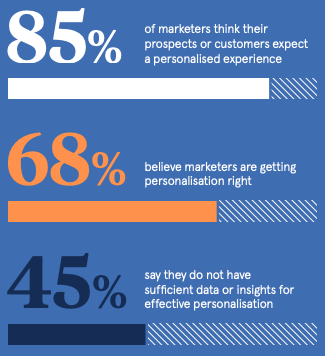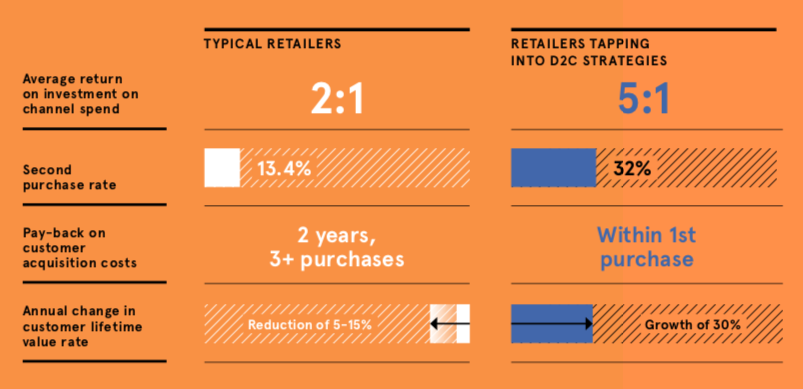
The State of Personalization in Retail: Raconteur Finds an Urgent Need for Change
“Pushing the frontiers of personalization”
“Why your strategy needs a shake-up”
“Digital native brands don’t own D2C”
The headlines in Raconteur’s latest report say it all. Personalization is no longer the future of retail; it’s happening now and brands that haven’t adjusted their strategies are falling behind. Here’s what you need to know.
Strategy Shakeup: Data Alone Doesn’t Yield Results, Turning Insights Into Action Does
Gartner recently released a bold claim: Marketers will abandon personalization by 2025. The analyst points to most organizations’ failure to deliver any meaningful return on investment from personalization initiatives to back up this claim.
However, Raconteur argues that it’s not the concept of personalization that has failed retailers, but rather a lack of understanding about how to effectively use data to deliver personalization.
The bottom line is, if marketers can’t understand data, then it’s useless. As Raconteur puts it: “Without the ability to understand [data] and act upon those insights, any attempt at personalization will go to waste.”

But as marketers become better about using data, will personalization become “creepy”? No. That’s because when personalization creates relevant experiences for consumers — by connecting them to products and offers in which they’re interested at a time when they’re ready to buy — it becomes useful, rather than creepy. In short, if brands keep surfacing products shoppers are interested in, they will keep eating it up.
Ultimately, Raconteur underscores the need to make a change sooner rather than later, advising that “the time of simply talking about personalization is coming to a close and the real work of doing it right is just beginning.”
The AI Future: Allowing AI to Do the Heavy Lifting for Marketers, Not Replace Them
Raconteur also explores the pros and cons of AI that recommends fashion for consumers (i.e. Stitch Fix). This study extends beyond simply using AI in fashion, though; it’s also quite telling about the role AI will play in retail going forward.
For example, Kieran O’Neill, co-founder and chief executive of menswear styling service Thread, tells Raconteur: “Our focus has always been on developing AI that can scale and improve the expertise of a [human] stylist, not replace it.”’ Stitch Fix echoes this sentiment, describing its product recommendation engine as “providing the science” behind recommendations and its stylists as “providing the art” behind them.
Altogether, this comes down to one point: The smartest marketers, armed with the smartest machines, will always beat machines operating on their own.
Rethinking Retail: Why Digital Native Brands Don’t Own D2C
So-called direct-to-consumer (D2C) brands like Warby Parker and Casper have put increasing pressure on more traditional retailers to be more agile and customer-centric while offering highly personalized experiences.
But it’s not just these digital native brands that own the D2C label. More established brands like Nike, Sephora and Timberland have become true D2C champions, using the latest technology to increase agility and deliver 1:1 customer experiences.
The rationale for this shift is clear. Brands tapping D2C strategies see a 5:1 average return on investment per channel spend, compared to an average 2:1 for typical retailers. They also see a 30% growth in customer lifetime value annually.

Results like these underscore that D2C strategies, notably the ability to personalize on a 1:1 level at scale, are critical to the future success of every retailer, not just digital natives. In fact, it will define the retailers that not only survive, but thrive.
Pushing the Frontiers of Personalization: Make Way for Personalization 2.0
Evolving consumer expectations and advances in AI have pushed the envelope on what’s expected from retail personalization. In fact, we’ve now entered the era of “Personalization 2.0,” in which hyper-personalized experiences don’t just sell to consumers, but actually predict what they want and when to deliver curated offers at the most relevant times.
As DuBose Cole, head of strategy at VaynerMedia London, puts it: “The next level of personalization shouldn’t always seem personalized, instead it should be fortuitous. Personalization 2.0 moves beyond personalizing the message, to additionally personalizing the context in which it engages a consumer. Like a good waiter, this technology and content must rapidly not just know our tastes, but be there when needed and be invisible when it isn’t.”
Cole hits on two points that will prove essential to success going forward. First, that the most effective personalization fosters proactive engagement by anticipating consumer wants and needs. And second, that personalization is as much about what brands don’t put in front of customers as it is about what they do put in front of them.
Get the Full Personalization Report
Take a deeper look into Raconteur’s report to learn more about the current state of personalization and the direction in which it’s heading, the expected impact of personalization and what marketers need to know about the technology and AI that makes it possible to deliver 1:1 experiences at scale. Download the full report here.





